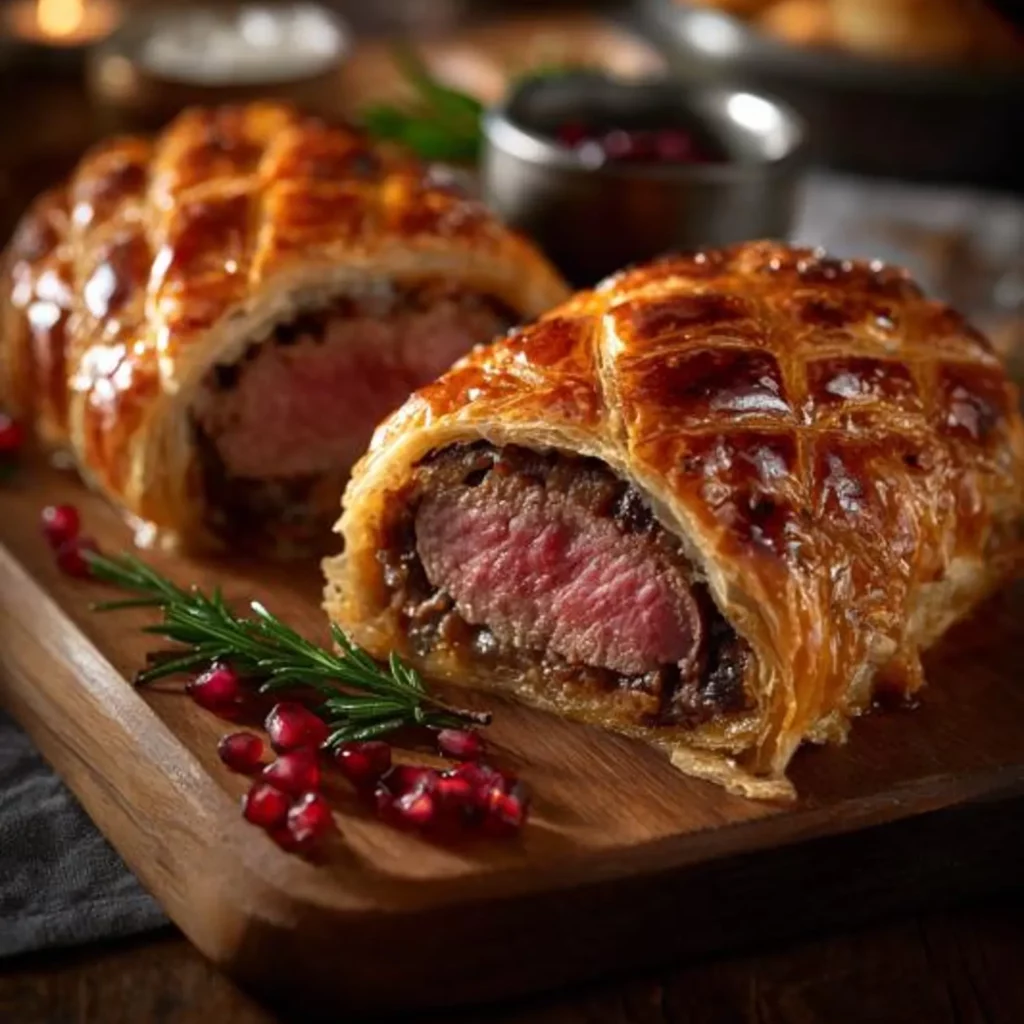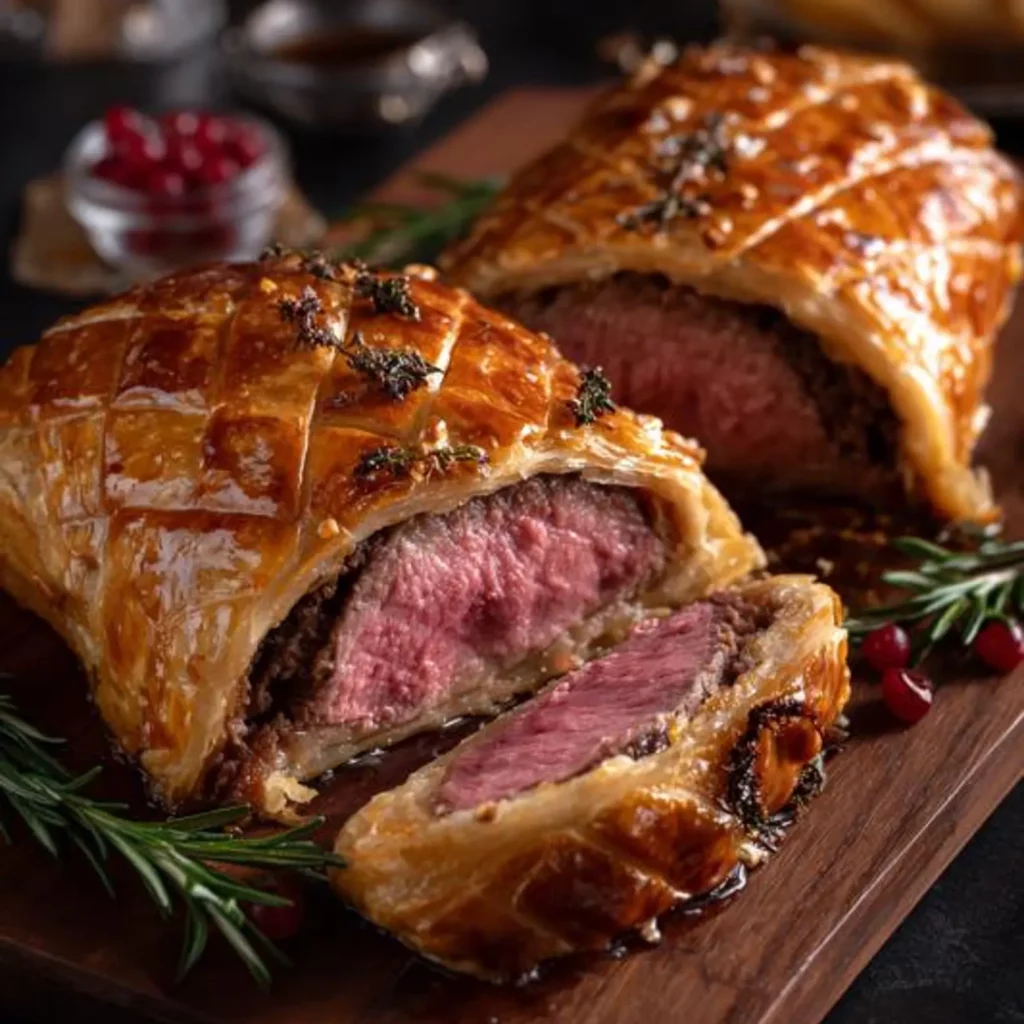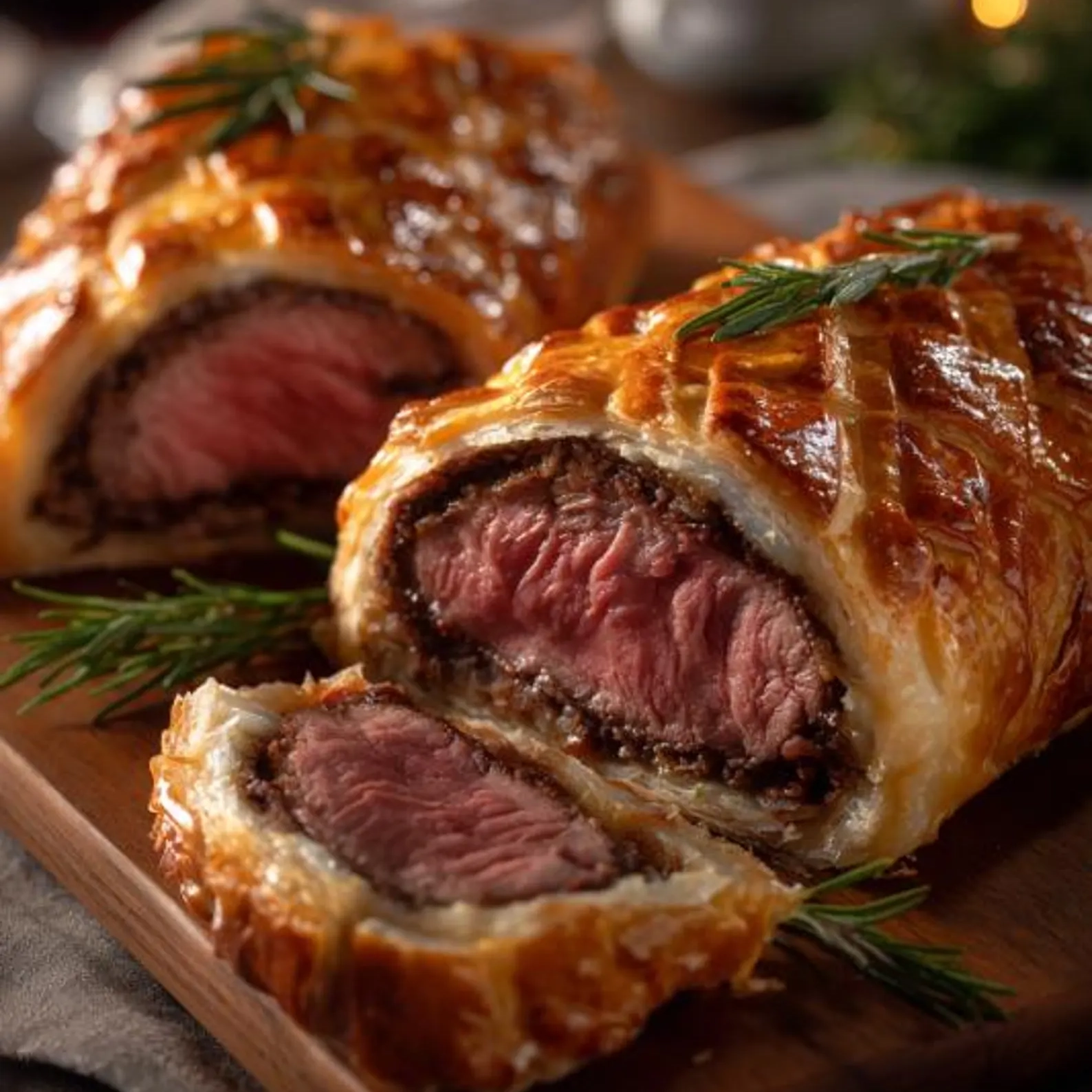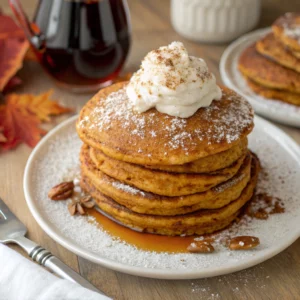Have you ever wondered what separates an ordinary dinner from a truly unforgettable culinary experience? The answer might just be a perfectly executed Beef Wellington. This iconic dish transforms a simple beef tenderloin into a masterpiece of flavors and textures that will leave your guests speechless.
Creating the perfect Beef Wellington might seem intimidating, but with the right guidance, you can master this classic holiday beef recipe and elevate your cooking skills to restaurant-quality levels. The combination of tender beef, savory mushroom duxelles, and flaky pastry creates a harmony of flavors that’s truly worth the effort.
Ingredients List
Gathering high-quality ingredients is the first step toward creating a memorable Beef Wellington. Each component plays a crucial role in building the complex flavors that make this dish so special.
- 2-pound center-cut beef tenderloin – Look for a piece with good marbling for optimal flavor and tenderness.
- 2 tablespoons olive oil – For searing the beef to perfection.
- 2 tablespoons Dijon mustard – Creates a flavorful barrier between the beef and duxelles.
- 1 pound mushrooms (cremini or button) – These form the base of your duxelles.
- 2 shallots, finely chopped – Adds subtle sweetness to the mushroom mixture.
- 4 cloves garlic, minced – For aromatic depth.
- 2 tablespoons fresh thyme leaves – Infuses the dish with earthy, herbaceous notes.
- 8 slices prosciutto – Creates a moisture barrier to prevent soggy pastry.
- 1 package (14 oz) puff pastry, thawed – The golden, flaky exterior that makes this dish so impressive.
- 1 egg, beaten – For that picture-perfect golden crust.
- Salt and freshly ground black pepper – Season to taste.
Possible Substitutions: No prosciutto? Try thin-sliced bacon or ham. Vegetarians can replace beef with a portobello mushroom stack. For gluten-free diets, seek out gluten-free puff pastry or create a nut-based crust.
Timing
Creating a Beef Wellington is a labor of love that rewards patience and attention to detail. Understanding the timing helps you plan accordingly and ensures a stress-free cooking experience.
- Preparation Time: 45 minutes (includes making duxelles and assembly)
- Resting Time: 30 minutes (for the seared tenderloin) + 15 minutes (after baking)
- Cooking Time: 35-40 minutes
- Total Time: Approximately 2 hours and 10 minutes
While this might seem lengthy compared to everyday recipes, it’s actually 15-20% faster than traditional Wellington recipes that can take up to 3 hours. The result is well worth the investment of time!

Step-by-Step Instructions
Step 1: Prepare the Beef
Season your tenderloin generously with salt and pepper on all sides. Heat olive oil in a large skillet over high heat until almost smoking. Sear the tenderloin for 2-3 minutes on each side until you achieve a beautiful brown crust. Remove from heat, brush all over with Dijon mustard, and set aside to cool completely (about 30 minutes). This cooling period is crucial – a warm tenderloin will start cooking the pastry before it goes in the oven.
Step 2: Create the Mushroom Duxelles
Pulse mushrooms, shallots, and garlic in a food processor until finely chopped. Cook this mixture in a dry pan over medium-high heat, stirring frequently. The goal is to remove all moisture – this typically takes 8-10 minutes. The mixture should resemble a paste. Add thyme leaves, season with salt and pepper, and continue cooking for another minute. Transfer to a plate and refrigerate until completely cool.
Step 3: Assemble the Wellington
- Lay out a large piece of plastic wrap on your work surface.
- Arrange prosciutto slices in a rectangle that’s slightly larger than your tenderloin, overlapping them slightly.
- Spread the cooled mushroom duxelles evenly over the prosciutto.
- Place the cooled tenderloin in the center.
- Use the plastic wrap to tightly roll the prosciutto over the beef, twisting the ends to secure. Refrigerate for 15-20 minutes to set the shape.
Step 4: Wrap in Pastry
Roll out the puff pastry on a lightly floured surface to about 1/8-inch thickness. Unwrap your beef from the plastic and place it in the center of the pastry. Fold the pastry over the beef, trimming any excess. Seal the edges with egg wash. Use remaining pastry for decorative elements if desired. Brush the entire surface with egg wash and refrigerate for 15 minutes to allow the pastry to firm up.
Step 5: Bake to Perfection
Preheat your oven to 425°F (220°C). Before baking, score the top of the pastry with a sharp knife (don’t cut too deep). Make a small hole in the top to allow steam to escape. Brush again with egg wash and sprinkle with flaky sea salt if desired. Bake for 35-40 minutes until the pastry is golden brown and the internal temperature reaches 125°F (52°C) for medium-rare. Let rest for 15 minutes before slicing.
Nutritional Information
Understanding the nutritional profile of your Beef Wellington helps you make informed choices about portion sizes and accompaniments. The following values are approximate per serving (based on 6 servings):
- Calories: 650 kcal
- Protein: 42g
- Carbohydrates: 24g
- Fat: 42g (15g saturated)
- Fiber: 2g
- Sodium: 850mg
This dish delivers approximately 70% of your daily protein needs and is rich in B vitamins, particularly B12, which supports nervous system function. The tenderloin is one of the leanest beef cuts, containing 40% less fat than other premium cuts like ribeye.
Healthier Alternatives for the Recipe
While Beef Wellington is inherently indulgent, several modifications can make it more nutritionally balanced without sacrificing its signature taste and texture:
Replace half the mushrooms with finely chopped walnuts or chestnuts to introduce heart-healthy fats and additional fiber. Opt for whole wheat or spelt puff pastry for increased fiber content. Consider using lean venison or bison instead of beef for a lower-fat alternative with a unique flavor profile.
For those monitoring sodium intake, reduce the prosciutto by half and compensate with additional herbs and spices. A tablespoon of brandy or cognac in the mushroom duxelles can enhance flavor without adding significant calories.
Serving Suggestions
The perfect accompaniments can elevate your Wellington from excellent to extraordinary. Balance the richness of the dish with sides that provide contrast in flavor, texture, and color.
Pair with roasted root vegetables tossed with fresh herbs and a light drizzle of honey. A bright arugula salad with lemon vinaigrette cuts through the richness beautifully. For a traditional approach, serve with creamy mashed potatoes and steamed green beans almondine.
Wine pairing is crucial: opt for a medium to full-bodied red like Bordeaux, Cabernet Sauvignon, or Malbec. The tannins help cleanse the palate between bites of the rich beef and buttery pastry.
Common Mistakes to Avoid
- Skipping the cooling stages: Patience is key. Working with warm ingredients causes the pastry to melt prematurely, resulting in a soggy bottom.
- Not removing enough moisture from the mushrooms: Damp duxelles lead to a soggy pastry layer. Cook until truly dry to the touch.
- Overcooking the beef: Remember that the tenderloin continues cooking inside the pastry. Aim for rare during the initial sear.
- Sealing the pastry too loosely: Ensure all seams are properly sealed with egg wash to prevent filling from escaping during baking.
- Skipping the resting period: Cutting immediately after baking causes juices to run out, resulting in dry beef and soggy pastry.
- Inconsistent oven temperature: Use an oven thermometer for accuracy, as many ovens run hotter or cooler than their settings indicate.

Storing Tips for the Recipe
While Beef Wellington is best enjoyed fresh from the oven, proper storage techniques can help preserve its quality for later enjoyment.
Refrigerate leftovers within two hours of cooking, tightly wrapped in foil or in an airtight container. Consume within 2-3 days for optimal flavor and texture. To reheat, warm in a 300°F (150°C) oven for 15-20 minutes rather than microwaving, which makes the pastry soggy.
For make-ahead preparation, you can assemble the Wellington up to the point of wrapping in pastry, then refrigerate for up to 24 hours before baking. Alternatively, freeze the assembled but unbaked Wellington for up to one month. Thaw completely in the refrigerator before baking.
Conclusion
Mastering Beef Wellington is a culinary achievement that combines technique, patience, and artistry. The harmonious blend of tender beef, umami-rich mushrooms, and golden pastry creates a dish that’s greater than the sum of its parts – a true centerpiece worthy of your most special occasions.
Whether you’re preparing it for a holiday feast, anniversary dinner, or simply to challenge yourself in the kitchen, this recipe provides all the guidance you need for success. We’d love to hear about your Wellington adventures! Share your results, adaptations, or questions in the comments below, and don’t forget to explore our other gourmet recipes that will elevate your home cooking to restaurant quality.





